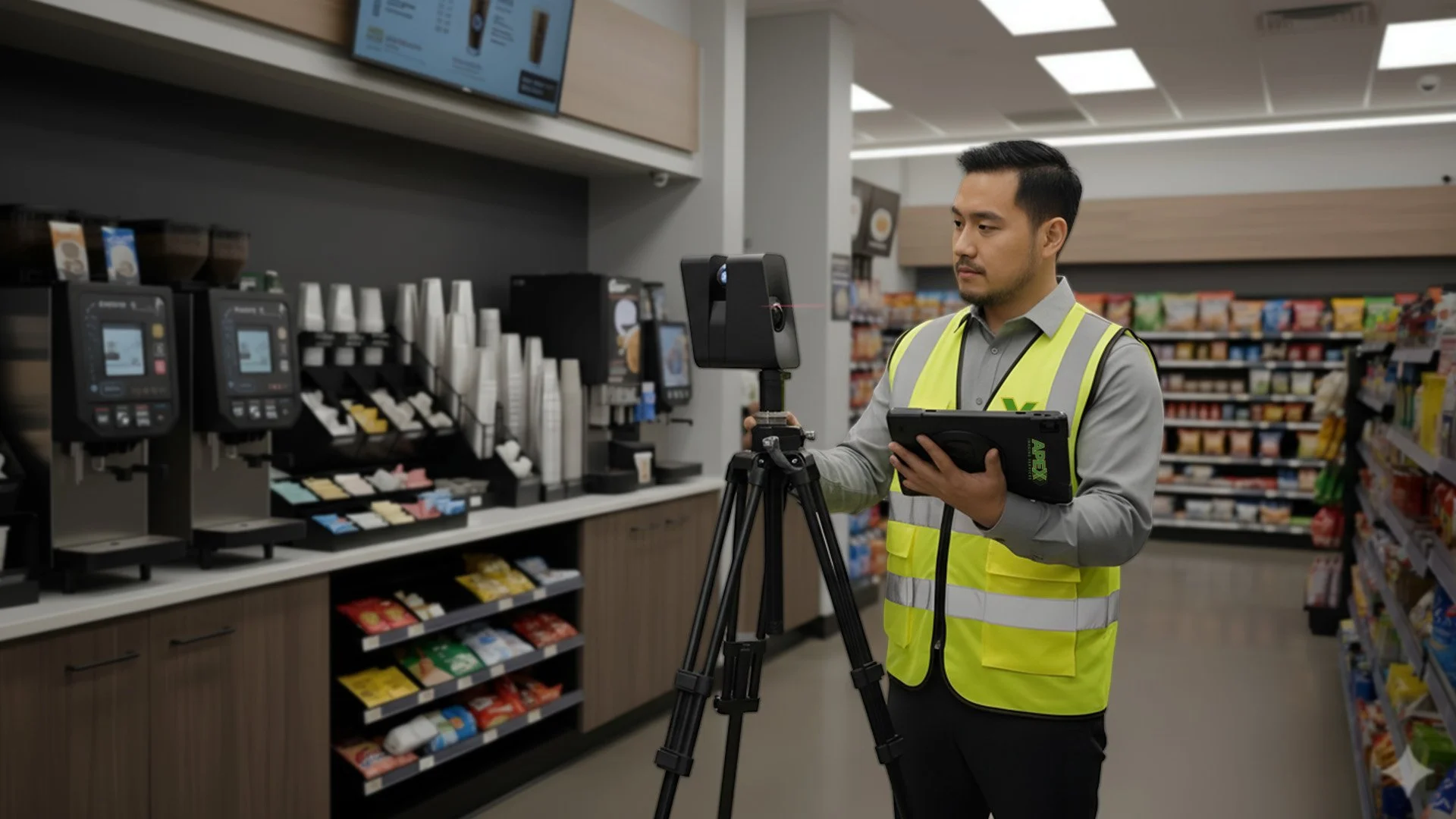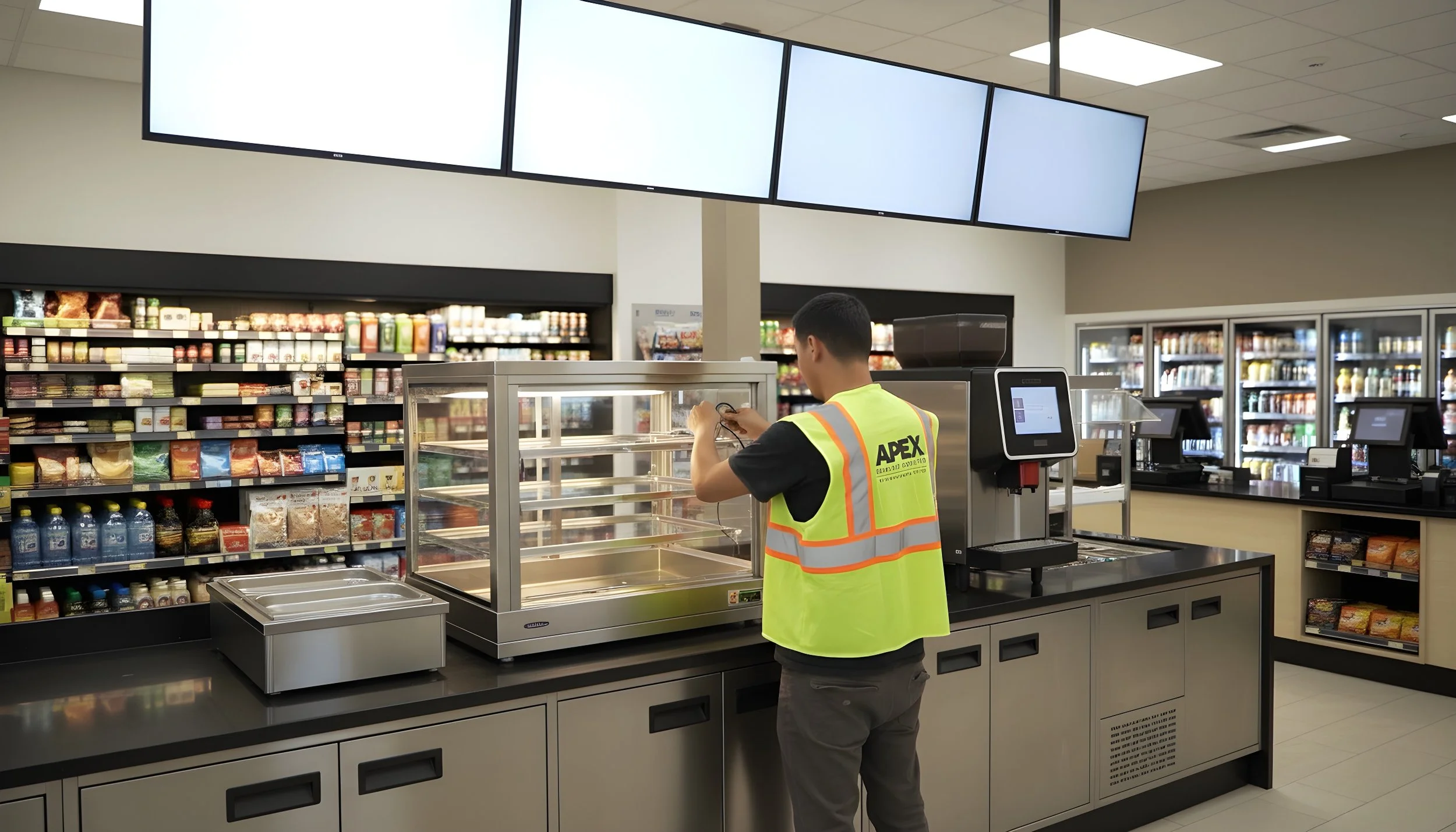3 Mistakes That Cause Convenience Store Food & Beverage Rollouts To Fail… and How to Fix Them
The secrets behind Apex’s Food Program FastTrack System™ that eliminate the chaos in C-Store food and beverage rollouts
It’s no secret that convenience store brands are racing to expand their food and beverage offerings—but most of these rollouts still break down for the same avoidable reasons. From delayed installs to inconsistent execution, executive leaders feel the pain in missed revenue and a lack of control… and execution leaders feel it in late nights, rework, and frustrated store managers.
The good news? These failures aren’t random. They come from three predictable strategic mistakes—and once you fix them, C-Store food and beverage launches become faster, smoother, and dramatically easier to scale.
Let’s break down the three mistakes… and show how the Apex Food Program FastTrack System™ eliminates each one at the source.
Mistake 1: Stores Aren’t Fully Validated Before the Rollout
Most C-Store food and beverage rollouts fall apart long before install day. The store wasn’t fully validated—not just physically, but digitally.
On paper, everything looks fine. In the field, the crew arrives and discovers:
Electrical access in the wrong place
Countertops or coolers that don’t fit the footprint
Clearance issues no one anticipated
Layout constraints that were never captured
Backroom pathways too tight to move equipment
Nothing derails a rollout faster than discovering truths on site that could’ve been known earlier.
Solution 1: Use Digital Twins to Validate Stores Before Install
A Digital Twin is the ultimate tool for helping teams prepare and collaborate before getting on-site. It’s why it’s one of the main pillars of Apex’s Food Program FastTrack System™, which helps our clients avoid the exact issues that delay and kill the budgets of most C-Store launches:
Eliminates the back-and-forth clarifications about dimensions, utilities, obstructions, counter depths, beverage bay spacing, etc.
Gives all teams (Merchandising, Facilities, Construction, Ops, Vendors, GC, etc.) a shared reality to make decisions from.
BONUS TIP:
Every Digital Twin, survey, measurement, utility constraint, equipment requirement, install spec, and store detail belongs in one centralized system. Not scattered across PDFs, emails, spreadsheets, and vendor portals. When everyone sees the same information, in the same format, nothing gets lost in translation.
Mistake 2: Splitting Ownership of the Equipment Package
One of the fastest ways to derail a food and beverage rollout is letting equipment ownership become fragmented. When brands try to manage one or two pieces themselves, or split responsibility across multiple vendors, the entire package stops behaving like a system.
Here’s what typically happens:
Pieces arrive across multiple shipments and multiple days
Boxes show up unlabeled or missing critical components
Equipment gets lost because the store didn’t have anywhere to store it
Installers open a box only to find parts that don’t match the spec
Any one of these issues can stall a project. But together, they create a chain reaction—installers can’t begin work, stores with downtime they can’t afford, return trips multiply, and training or activation events are pushed back.
Execution teams lose momentum.
Leadership loses confidence.
And the brand loses revenue.
Solution 2: Give One Party Full Ownership And Accountability for the Equipment Package
When equipment ownership is unified, the rollout suddenly starts behaving like a system again. The fastest way to fix the mistake many make in this area is to let one party take full responsibility for everything the field needs… in one complete, predictable delivery.
Build one consolidated kit for each store
Every component should be verified, labeled, and packed together so installers receive a single, complete package prepared specifically for that location.
This removes the usual friction… no scattered shipments, no surprises, no on-site scavenger hunts.
Time the delivery to land just before the install window
Early deliveries overwhelm stores with gear they have no space to stage. Late deliveries leave crews idle. The ideal approach is one clean drop 1-2 days before install, so the field can go straight to work.
For those who want even more predictability, our Director of Construction, Jay Kassity, recommends:
“Ideally, everything lands on Friday for a Monday start so my team can inventory it and fix any missing or damaged pieces before it impacts the install.”
When the package arrives complete and on time, everything downstream gets easier.
Installs move faster
Downtime drops
Return trips disappear
And the field stops spending energy managing logistics and starts spending it executing the actual work.
It’s why C-Store clients appreciate leveraging this pillar of our Food Program FastTrack System™. All equipment and materials flow through Apex’s internal warehousing and consolidation, where they are inspected, packaged, and shipped as one unified drop. Installers receive exactly what they need, all at once, without relying on third-party timing or guesswork.
Now let us assume you have addressed the first two mistakes. You have validated every store with Digital Twins. You have given one party full ownership of the equipment package. Even with all of that in place… there is still one mistake that can grind a convenience store food and beverage rollout to a halt.
Mistake 3: Leaving Multi-Trade Installs to Disconnected Subcontractors
Too many C-Store teams fall for the illusion that swapping and installing a new piece of food or beverage equipment is simple.
On the surface, it looks easy: a coffee machine in, a beverage unit out, a fryer swapped, a countertop replaced. Executive leaders often see it as “basic” work. Execution leaders know it’s anything but.
Because the truth is: These are multi-trade, overnight installs that appear simple… but are deceptively complex.
And when no one owns all the trades involved, even the cleanest rollout prep can fall apart on install. A seemingly “simple” and “quick” swap might require:
20 minutes of plumbing time
An hour of electrical work
A cabinet modification
HVAC adjustments or filter swaps
Finish carpentry
Cutting, lifting, anchoring, sealing
Testing and balancing
Ensuring the new unit turns on and functions before open
And all of this has to happen:
Overnight
in a tight window
often unsupervised
with near-zero margin for error
With the goal of the store opening fully functional the next morning
If even one trade isn’t aligned, plumbing, electrical, HVAC, or millwork, the whole install stalls. The machine doesn’t turn on the next morning—that’s the real risk of fragmentation.
Solution 3: One Team Must Own the Multi-Trade Install
This is the step most C-Store brands miss. Food and beverage rollouts don’t fail because you need more trades. They fail because too many different vendors are involved.
When the plumber, electrician, millwork tech, and HVAC tech all come from separate companies, you get the same issues every time:
Crews wait on each other
Steps happen out of order
Parts of the system don’t match up
No one tests everything as a whole
No one owns the final “turn-on” moment
And that’s when stores open the next morning and the equipment doesn’t work.
Lynelle Grimes, Director of Business Development, said it well:
“It seems deceptively easy… but someone has to own the whole process.”
This is why Apex uses our own certified and W2 technicians across multiple markets, so installs are done the same way every time. That means consistent work, consistent calibration, and a consistent customer experience from store to store.
Jay explained it simply, “Our certified and W2 technicians give us consistency market to market. If a soda machine isn’t calibrated right, Coke doesn’t taste like Coke… and that loses customers.”
With one unified team, Apex handles every trade and every step. They know how the whole system is supposed to work and make sure it works before the store opens.
This is why a single accountable team is a key part of Apex’s Food Program FastTrack System™. It’s the only reliable way to make sure everything is working by the time customers walk in the next morning.
Your C-Store Deserves Better Food & Beverage Rollouts
With Apex’s Food Program FastTrack System™, every store gets a consistent, on-time install backed by one accountable team. If you’re planning a food or beverage upgrade, we’d love to support your next program. Connect with a rep here >




